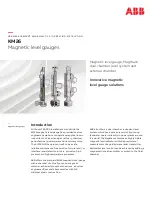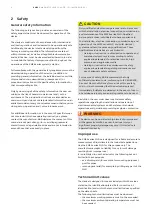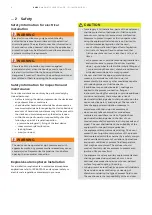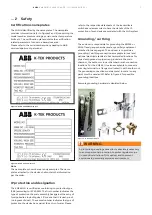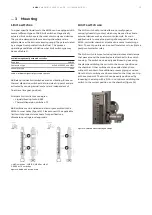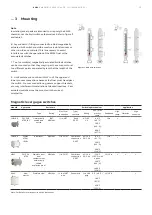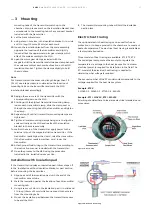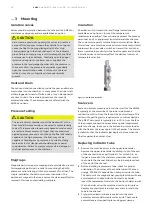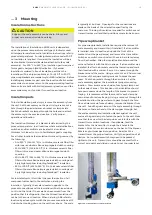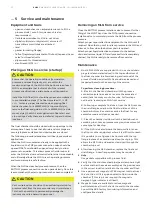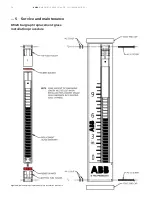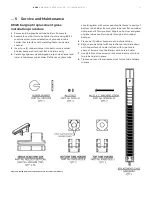
12
KM26 |
MAGNETIC LEVEL GAUGE | OI/KM26-EN REV I
. . . 3 Mounting
Pressure equalized (vented) floats require special
provisions when being brought into and out of service.
Gradual increases / decreases of pressure in the chamber,
in increments not to exceed the pressure limits of the
float, must be performed. A one-minute wait period
between increments is necessary to ensure that the float
does not collapse or burst. Equalizing the internal and
external pressure of the float will prevent float damage.
Contact the applications engineering department at the
factory for assistance.
CAUTION
Float Curve
For applications involving liquids that tend to vary in density,
the ABB provides the Float Curve that will display the
anticipated error, should the specific gravity change. By
simply drawing a vertical line from the x-axis (liquid SG) to the
curve, you can reference the length of the float that is
submerged in the liquid.
For example:
1
Float designed for water (1.0 SG)
2
At 1.0 SG, the float projects 6.25 in (15.9 cm) into the
liquid
3
If the media SG changes to 1.3, the visual indicator will
show positive error
4
By referencing the graph, the expected float projection at
1.3 is approximately 5.88 in. (15 cm)
5
By use of subtraction, the float is reading high by 0.37
inches (1 cm)
6
A 1 centimeter position adjustment on the indicator can
correct the error
Indicator assembly
The indicator assembly (figure 12), consisting of a glass or
polycarbonate tube, an indicator (shuttle or magnetic bar
graph) and a graduated scale, is installed parallel and in close
proximity to the float chamber. This is necessary to allow for
maximum magnetic coupling between the float and the
indicator. The indicator and tube are mounted in a stainless
steel channel which has a graduated scale attached. The
graduations on this scale correspond to the desired
operating range. The glass indicator tube is an IP68 certified
hermetically sealed which prevent the ingress and
accumulation of dust and moisture. The indicators are
painted with high visibility paint so readings can be obtained
from long distances. The scale is delivered correctly set up for
measuring the product specified in the order. The optional
magnetic bar graph indicator is available in yellow / black or
red / white for use in locations where temperature is not
excessive. The flippers on the bar graph rotate to change
color at the fluid level. The indicator tube is positioned such
that the normal downward travel of the float is stopped at a
position that corresponds to the scale zero by a spring
mounted on the bottom flange for the KM26S and a float stop
tube for the KM26T. Therefore, as long as the float and the
shuttle are magnetically coupled, the shuttle will be visible.
Both the KM26S and the KM26T are equipped with a float
stop spring at the top of the chamber. These springs absorb
the force on the float that occurs if fluid levels change rapidly
in the chamber and propel the float up or down.
Types of indicator
There are two main types of indicators—shuttle and bar-
graph.
Shuttle
The shuttle (bullet or follower) indicator consists of a small,
orange-colored cylinder with an embedded magnet that
moves freely in a glass or plastic tube attached to the scale
assembly which is externally mounted to the chamber.Shuttle
indicators are often specified in lower cost configurations. It
provides a visual indication that is suitable for many
applications, except where flashing or extreme turbulence
occurs within the process vessel which can result in erratic
float movement causing it to become magnetically decoupled
from the shuttle. The shuttle must then be manually reset by
raising it with a strong external magnet to recouple it back to
the magnetic field of the float.
Bar-graph
The bar-graph indicator is a system of small panels of
material with highly contrasting colors on opposite sides. The
bar-graph is also called as flags or flappers. Each flag
contains a magnet that allows it to couple to the float. As the
float moves up or down with the liquid level, each flag rotates
to display a color that directly reflects its position in relation
to the float. Flags above the float magnet will be oriented
with the front of flag visible, while the flags below the float
magnet will have the back of flags visible in the indicator.
These indicators are more robust than shuttle indicators.
Figure 12 - KM26 indicator assembly

